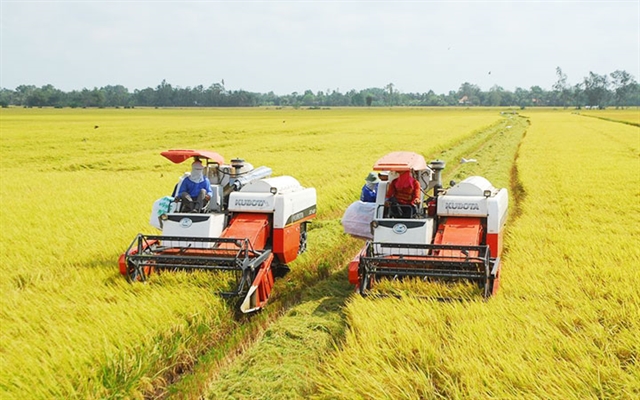 Economy
Economy


|
| Farmers harvest rice in Cửu Long (Mekong) Delta region. — Photo chinhphu.vn |
Compiled by Thiên Lý
How to ensure prices of produce do not plummet when farmers have bumper crops is a question that has been circulating for many years, especially in the Cửu Long (Mekong) Delta.
According to market observers, agricultural production in the delta, the country’s biggest rice, fish and fruit producer, is hampered by many factors, making it less competitive than neighbouring countries like Thailand, Myanmar and Cambodia.
They include the small scale of production, lack of processing and thus added value and poor links between production and consumption.
The delta is short of establishments designated to buy and sell local farmers’ produce, and the transport infrastructure there is still very poor, meaning, for distribution elsewhere or export, 70 per cent of the goods need first to be transported by road to HCM City or the Bà Rịa-VũngTàu Province.
Huỳnh Thanh Thọ, a farmer in Cần Thơ City’s Bình Thuỷ District, has been farming fish in the Hậu River for more than 20 years.
The biggest difficulty facing the farmers like him in the delta is finding steady outlets for their output.
They are often unable to find outlets, especially when they have bumper harvests, and so are compelled to sell at very low rates.
Last year he suffered a loss of VNĐ2 billion (US$86,957) in revenues since he had to barter away 200 tonnes of thác lác fish (chitala ornate)
Võ Lê Thành of the Trung Xuyên Agricultural Cooperative in Cờ Đỏ District in Cần Thơ said the situation had worsened during the COVID-19 pandemic which began in early 2020 and is impacting most southern provinces.
“Farmers like me were unable to sell our products due to strict social distancing orders by localities to prevent the spread of COVID-19. Meanwhile, we have had to cope with sharp increases in the prices of fertilisers and pesticides.”
A similar situation has also plagued the south-eastern region.
Lê Văn Quyết, deputy chairman of the Southeastern Provinces Animal Husbandry Association, said chicken farmers in some places had been struggling to sell their produce since many slaughterhouses closed due to COVID cases or lack of workers.
Consequently, they incurred big losses and had to reduce their flocks by 40 per cent to cut costs, he said.
Trần Lâm Sinh, deputy director of the Đồng Nai Department of Agriculture and Rural Development, said the province had a surplus of thousands of pigs, 200,000 white chickens and large quantities of fruits, vegetables and seafood during the period.
Many dragon fruit farmers in Bình Thuận Province had to throw away their harvests since they could not sell them.
Experts say social distancing in HCM City and other southern provinces, which restricted travel and businesses’ operations, disrupted distribution and prevented slaughter houses from opening, thus affecting supply of farm products including livestock.
Solutions
According to many experts, there was an oversupply of agricultural produce, especially in southern provinces in bumper crops.
It was exacerbated by the lack of connectivity between production and sales points.
For instance, Vĩnh Châu purple onion sold for VNĐ5,000-6,000 per kilogramme in SócTrăng Province, where it is grown, but at VNĐ45,000 in the Central Highlands province of Đắk Lắk, they pointed out.
To try and resolve this problem, an official from the Ministry of Agriculture and Rural Development said the ministry was developing a standard trading system for agricultural produce grown in the country.
It would work with various agencies to identify some areas in Hà Nội, HCM City and other localities to launch standardized distribution models for agricultural products to protect farmers from low prices whenever they have a bumper crop, he said.
In the long term the agricultural sector needed to establish a two-way information channel, he said.
It should be used, 15-20 days before harvesting any farm produce, by local agriculture departments to inform the ministry about when the harvest would begin, he said.
The ministry would then work with distribution systems to make suitable plans for purchase and sales to avoid oversupply, he said.
Local agriculture departments should take the responsibility of not only helping farmers grow crops and raise livestock but also selling them, he said.
“That is the difference between agricultural production thinking and agricultural economic thinking.”
He also stressed the need for setting up close links between producers and the market to foster efficiency in the trading of agricultural produce.
The Government also envisages other solutions like promotion of digital transformation to facilitate the information links between producers and distributors.
The agriculture ministry has been instructed to set up a database with up-to-date information about harvests in provinces and outputs.
Based on this information, distributors can make plans for warehousing, transportation and sales of produce.
Centre for delta
Besides, many experts also expect that southern farmers’ difficulties in selling their produce will soon be resolved thanks to a resolution recently passed by the National Assembly to build a centre that will link up farm production, processing and trading activities in the delta.
To be built in the CầnThơ City, it will provide various services for production and trading of farm produce, helping set up a network of suppliers, processors, distributors, exporters, and importers.
It will have large, modern cold storages that will preserve agricultural products for up to 90 days instead of the seven currently.
Prof Võ Tòng Xuân, director of the Southern Cần Thơ University, said the establishment of a centre to connect farmers with production, processing and consumption enterprises in the delta was imperative, especially amid the need to restructure agriculture because of climate change.
Dr. Trần Hữu Hiệp, an economist based in the delta, said the centre was likely to be an important factor in the sustainable development of the region’s agricultural economy.
Xuân said the centre must update information on export markets for enterprises to grasp market demand in a timely manner.
But this would require human resources good enough to manage the data bases, he said.
Hiệp said the centre needed to attract investments to build a multi-functional logistics system that would be operated with digital platforms to ensure that all steps in agricultural production operate smoothly.
But experts warned that centres like the one proposed in Cần Thơ would not be magic wands that settle all problems related to sales of agricultural products in the southern region, and more mechanisms and policies to effectively connect delta provinces with those elsewhere are required. — VNS




